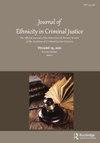种族、SES和种族刻板印象犯罪对陪审团针对东亚裔美国被告的裁决偏见影响的厌恶性种族主义解释
IF 1
Q3 CRIMINOLOGY & PENOLOGY
引用次数: 0
摘要
厌恶种族主义是当代种族主义的一种微妙形式,适用于那些可能持有平等主义价值观的人,它被用来解释陪审员对黑人和拉丁裔美国人被告的偏见,但尚未将东亚裔美国人被告作为偏见的对象。在进行了一项针对亚裔美国人和白人美国人的种族刻板印象犯罪的试点研究之后,主要研究的目的是从厌恶种族主义的角度来检验模拟陪审员对东亚美国被告的偏见。采用2(种族:美国白人或东亚美国人)× 2(社会经济地位:低或高)× 2(种族-典型犯罪:贪污或电脑黑客)被试间设计。参与者被随机分配阅读描述被告涉嫌犯下的罪行的八篇审判小短文中的一篇。然后,他们被要求做出判决,建议量刑,并根据各种罪责和性格指标对被告进行评分。结果显示,模拟陪审员对低社会经济地位的东亚裔美国被告的判决比其他所有条件下都要严厉。模拟陪审员也认为被告更有罪,并对他的一些特征进行了更负面的评价。讨论了局限性和未来发展方向。本文章由计算机程序翻译,如有差异,请以英文原文为准。
An aversive racism explanation for the influence of race, SES, and race-stereotypical crimes on jury decision biases against East Asian American defendants
Abstract Aversive racism, a subtle form of contemporary racism for persons who may hold egalitarian values, has been used to explain prejudice by jurors toward Black American and Latinx American defendants, but has yet to examine East Asian American defendants as targets of prejudice. After conducting a pilot study to find race-stereotypical crimes for Asian Americans and White Americans, the purpose of the main study was to examine mock jurors’ prejudice toward East Asian American defendants from an aversive racism perspective. A 2 (Race: White American or East Asian American) x 2 (SES: low or high) x 2 (Race-Stereotypical Crime: embezzlement or computer hacking) between-subjects design was conducted. Participants were randomly assigned to read one of eight trial vignettes describing the crime the defendant had allegedly committed. They were then asked to render a verdict, recommend a sentence, and rate the defendant on various culpability and trait measures. Results showed mock jurors sentenced the low SES East Asian American defendant who committed a race-stereotypical crime more punitively than all other conditions. Mock jurors also found this defendant more culpable and rated him more negatively on a number of trait ascriptions. Limitations and future directions are discussed.
求助全文
通过发布文献求助,成功后即可免费获取论文全文。
去求助
来源期刊

Journal of Ethnicity in Criminal Justice
CRIMINOLOGY & PENOLOGY-
CiteScore
1.70
自引率
16.70%
发文量
16
期刊介绍:
The Journal of Ethnicity in Criminal Justice explores the prejudice that currently affects our judicial system, our courts, our prisons, and our neighborhoods all around the world. This unique multidisciplinary journal is the only publication that focuses exclusively on crime, criminal justice, and ethnicity/race. Here you"ll find insightful commentaries, position papers, and examinations of new and existing legislation by scholars and professionals committed to the study of ethnicity and criminal justice. In addition, the Journal of Ethnicity in Criminal Justice presents the latest empirical findings, theoretical discussion, and research on social and criminal justice issues.
 求助内容:
求助内容: 应助结果提醒方式:
应助结果提醒方式:


